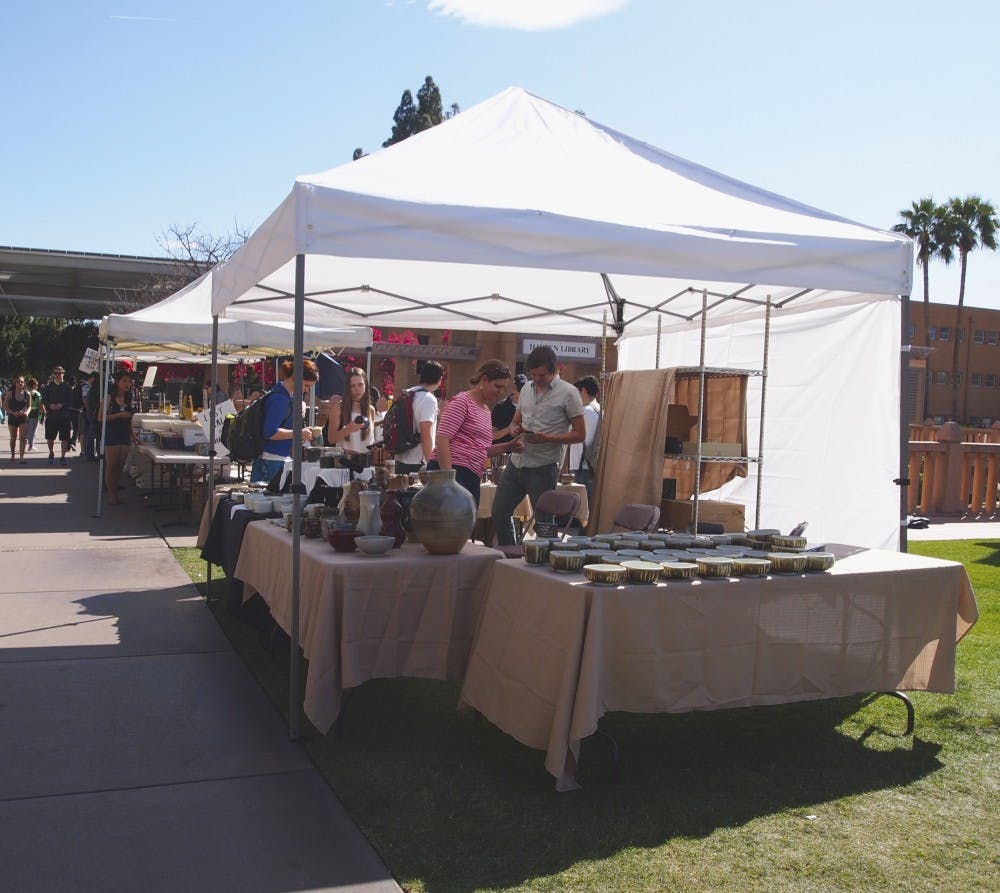Glimmering cups, bowls, pitchers and small sculptures, situated between boxes of used books and stationary bikes, covered tables spread across Hayden Lawn Tuesday at the annual Clay Club sale.
Clay Club, which began after Associate Art Professor and ceramic artist Susan Beiner joined ASU faculty in 2006, is made up of mostly ceramic students looking to work with other students and promote ceramics at ASU.
Secondary education and English freshman Bianca Galindo was one of many people who stopped by the art sale and purchased some items.
“I bought a little baby head,” Galindo said. “I picked the cream one because it looks the most neutral. I picked it because I like it; it looks like a little Buddha head.”
Between 75 and 100 individual pieces of ceramic were created by hand, glazed and fired at the ASU ceramic studio in preparation for the sale.
The baby head Galindo bought was one of the many pieces music theory student Hans Miles created for the sale. He used a plastic doll head, covered it in a material called slip and then made a mold, which he then used to produce multiple heads.
However, not all of the work for sale is made from molds or made to be strictly decorative. In fact, most of the work was made on the wheel, a process of molding a shape out of clay as it spins on a flat surface. This process is best for making symmetrical cylindrical shapes such as cups and bowls. Cups of all shapes and sizes were featured at the sale, with all kinds of glazes to give interesting colors and effects.
Even Sam Chung, another one of ASUs’ arts assistant professor and ceramic artist, included some of his work at a discounted price, just to raise money for Clay Club.
Ceramic arts junior and Clay Club president Carli Giese created ceramic necklaces with multi-colored glass melted on them for sale, as well as necklaces made from twine with little ceramic heads the size of shelled peanuts.
From conception to completion, the process of making the ceramic goods can take more than a week, said Giese.
“The sale makes a lot of money for students, more than they would expect,” Giese said. “It makes a lot of money for Clay Club too.”
In fact, the profit from the sale goes in part to the student who created the work and in another part to the club.
The club invites artists to educate members on different methods of ceramic creation, glazing and firing. The club also sponsors charity events such as Tempe Empty Bowls, which takes donated bowls from Clay Club and local schools and fills them with soup and then sells the meal to raise money for the Tempe Community Action Agency, United Food Bank and the Escalante Community Garden.
“We have guest speakers, events and meetings,” Giese said.
Because little funding comes from ASU, Clay Club conducts sales to raise money for its events.
The Clay Club will continue to host the sale on Hayden Lawn Wednesday and Thursday from 10 a.m. to 6 p.m. and it will hold an Earth Day sale on April 21st from 9 a.m. to 6 p.m. at the ASU Farmers Market on campus.
Also out on Hayden Lawn Tuesday was the biannual used book sale, sponsored by the Prison Education Awareness Club, a student organization that educates about prison reform and focuses on prison education, according to its website.
Part of the proceeds of the book sale go to the club, while the remainder funds the book sale which travels between 28 different campuses, mostly in California, said Erik Kessler, book sale owner.
Pi Kappa Phi hosted its annual Bike-A-Thon at the same time as the sales. The fraternities’ national philanthropic arm, The Ability Experience, raises money for disabled people and has seven stationary bikes ridden for 48 hours straight to symbolize that people with disabilities never stop, said Calum Robertson, fraternity member and supply chain management sophomore.
Reach the reporter at cmclevel@asu.edu.
Like The State Press on Facebook and follow @statepress on Twitter




